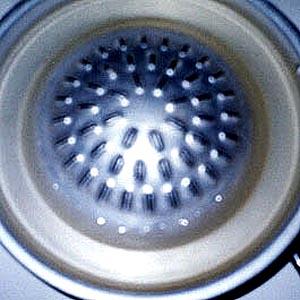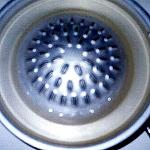Moo Ga-ta for All Seasons
A ga-ta is a pan shaped somewhat like a derby hat whose brim has been turned up so that a reservoir is formed around the hat's perimeter. In the top of the pan are a number of tiny slits, and below the pan is placed a big chunk of red-hot charcoal.
* * * * *
Recently I accompanied some friends to a costume party, which would eventually include stand-ins for Britney Spears, a Thai Marxist, a flapper, and three motorcycle taxi drivers. One of my friends wore around his torso what looked to be a kind of flying saucer made of cardboard and aluminum foil. When asked who or what he was supposed to be, he earnestly replied that he was a moo ga-ta. This is somewhat like declaring that you are a wok or a rice cooker, except that a moo ga-ta is more obscure.
A ga-ta is a pan shaped somewhat like a derby hat whose brim has been turned up so that a reservoir is formed around the hat's perimeter. In the top of the pan are a number of tiny slits, and below the pan is placed a big chunk of red-hot charcoal.
Here's how it works: First you order some vegetables (lettuce, cabbage, morning glory, and scallions) and slices of raw meat (chicken, beef, squid, prawns, assorted fish, liver, or pork -- the moo of moo ga-ta.) You also get one raw egg, some glass noodles, and the spicy sauce nahm jeem.
After a waiter pours boiling water into the reservoir, you fill it with vegetables, noodles, and the egg. While this bubbles, you put the meat slices on the top of the pan. As they cook, their juices will run down into the reservoir and - voila! - make soup. As the slices become cooked, you pluck them off using chopsticks and add more. The nahm jeem may be added to your soup, or used as a dip for the meat slices.
Now and again the waiter returns to replenish the reservoir with boiling water. You may also be given some strips of fat, which are placed on the top of the ga-ta to prevent sticking. When the fat shrivels and blackens, it can also be eaten. Indeed, the Thais consider it a delicacy.
My friend's costume included the foods: cardboard cutouts of chicken drumsticks and stylized squid. He wore a kind of gauze bag on his head - "that's the fat," he explained. "You know," he confided, "chicks really dig the ga-ta." We discussed the universal appeal of food.
Some restaurants are devoted primarily to moo ga-ta, and many - especially in Chiang Mai - offer an "all-you-can-eat" option. Otherwise, you pay per set of meats or veggies. Still, two people can gorge themselves for as little as 200 baht.
In eating moo ga-ta, everyone is at once chef and gourmand, so the more people involved, the merrier. Moo ga-ta is often a family affair, and many Thais have their own ga-ta for special family gatherings.
There are a few disadvantages to this style of eating. It is labor intensive, and the heat and grease the pan throws off can be a turn-off. You might find yourself wiping your brow by the time it's over.
My costumed friend, alas, met a similar fate. His brow dotted with perspiration, he complained, "Man, this thing is hot." Aptly, he treated his own "reservoir" to a cold beverage and, pointing to his cardboard food, asked me, "Hungry?"
- The End -
 ThingsAsian
ThingsAsian

















